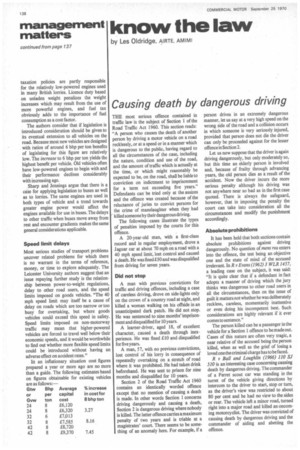know the law
Page 140

If you've noticed an error in this article please click here to report it so we can fix it.
by Les Oldridge, AIRTE, AMIMI
Causing death by dangerous driving
THE most serious offence contained in traffic law is the subject of Section 1 of the Road Traffic Act 1960. This section reads: -A person who causes the death of another person by driving a motor vehicle on a road recklessly, or at a speed or in a manner which is dangerous to the public, having regard to all the circumstances of the case, including the nature, condition and use of the road, and the amount of traffic which is actually at the time, or which might reasonably be expected to be, on the road, shall be liable to conviction on indictment to imprisonment for a term not exceeding five years." Defendants can be tried only at the assizes and the offence was created because of the reluctance of juries to convict persons for the crime of manslaughter when they had killed someone by their dangerous driving.
The following cases illustrate the types of penalties imposed by the courts for this offence.
A 20-year-old man, with a first-class record and in regular employment, drove a Jaguar car at about 70 mph on a road with a 40 mph speed limit, lost control and caused a death. He was fined £50 and was disqualified from driving for seven years.
Did not stop A man with previous convictions for traffic and driving offences, including a case of careless driving, drove on side-lights only on the crown of a country road at night, and killed a woman walking on his offside in an unanticipated dark patch. He did not stop. He was sentenced to nine months' imprisonment and disqualified for 10 years.
A learner-driver, aged 18, of excellent character, caused a death through inexperience. He was fined £10 and disqualified for five years.
A man, 57, with no previous convictions, lost control of his lorry in consequence of repeatedly overtaking on a stretch of road where it was prohibited. He had taken drink beforehand. He was sent to prison for nine months and disqualified for 10 years.
Section 2 of the Road Traffic Act 1960 contains an identically worded offence except that no mention of causing a death is made. In other words Section 1 concerns driving dangerously and causing a death, Section 2 is dangerous driving where nobody is killed. The latter offence carries amaxirnum penalty of two years and is triable at a magistrates court. There seems to be something of an anomaly here. For example, if a person drives in an extremely dangerous manner, let us say at a very high speed on the wrong side of the road and a collision occurs in which someone is very seriously injured, provided that person does not die the driver can only be proceeded against for the lesser offence in Section 2.
Let us now suppose that the driver is again driving dangerously, but only moderately so, but this time an elderly person is involved and, because of frailty through advancing years, the old person dies as a result of the accident. Now the driver incurs the more serious penalty although his driving was not anywhere near so bad as in the first case quoted. There is always the safeguard, however, that in imposing the penalty the court can take into consideration all the circumstances and modify the punishment accordingly.
Absolute prohibitions It has been held that both sections contain absolute prohibitions against driving dangerously. No question of mens rea enters into the offence, the test being an objective one and the state of mind of the accused irrelevant. In R v Evans (1962) 3 WLR 1457, a leading case on the subject, it was said: "It is quite clear that if a defendant in fact adopts a manner of driving which the jury thinks was dangerous to other road users in all the circumstances, then on the issue of guilt it matters not whether he was deliberately reckless, careless, momentarily inattentive or even doing his incompetent best. Such considerations are highly relevant if it ever comes to sentence."
The person killed can be a passenger in the vehicle for a Section 1 offence to be made out. Cases of this nature are often very tragic, a near relative of the accused being the person killed, when as well as the grief of losing a loved one the criminal charge has to be faced.
R v Ball and Loughlin (1966) 110 SJ 510 is an interesting case concerning causing death by dangerous driving. The commander of a Ferret scout car was standing in the turret of the vehicle giving directions by intercom to the driver to start, stop or turn, as the driver's view was restricted to about 80 per cent and he had no view to the sides or rear. The vehicle left a minor road, turned right into a major road and killed an oncoming motorcyclist. The driver was convicted of causing death by dangerous driving and the commander of aiding and abetting the offence.


























































































































































































